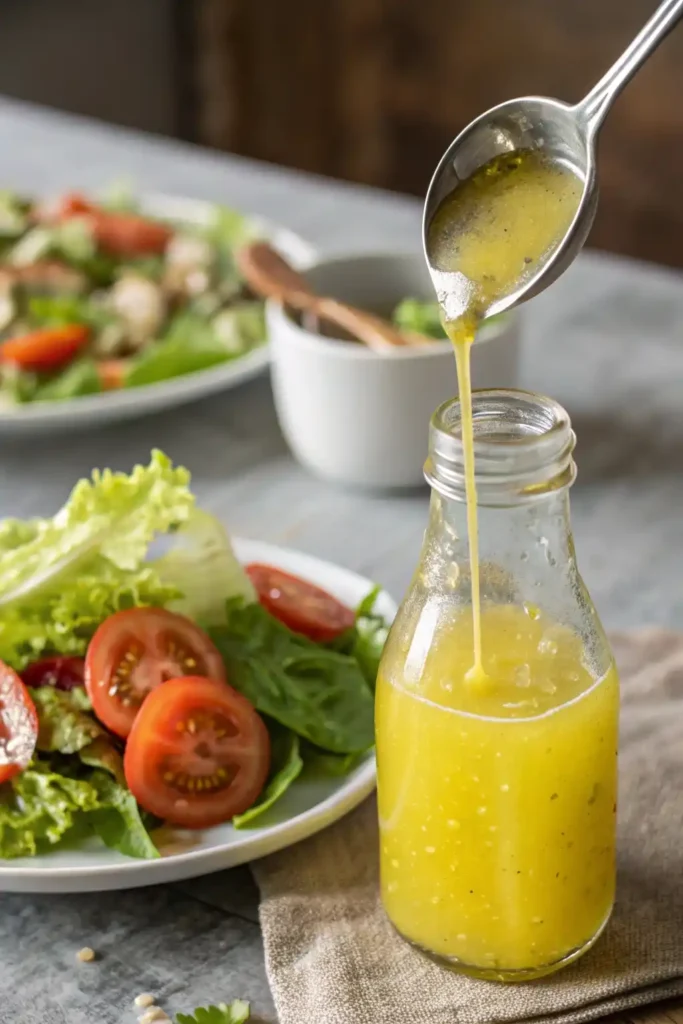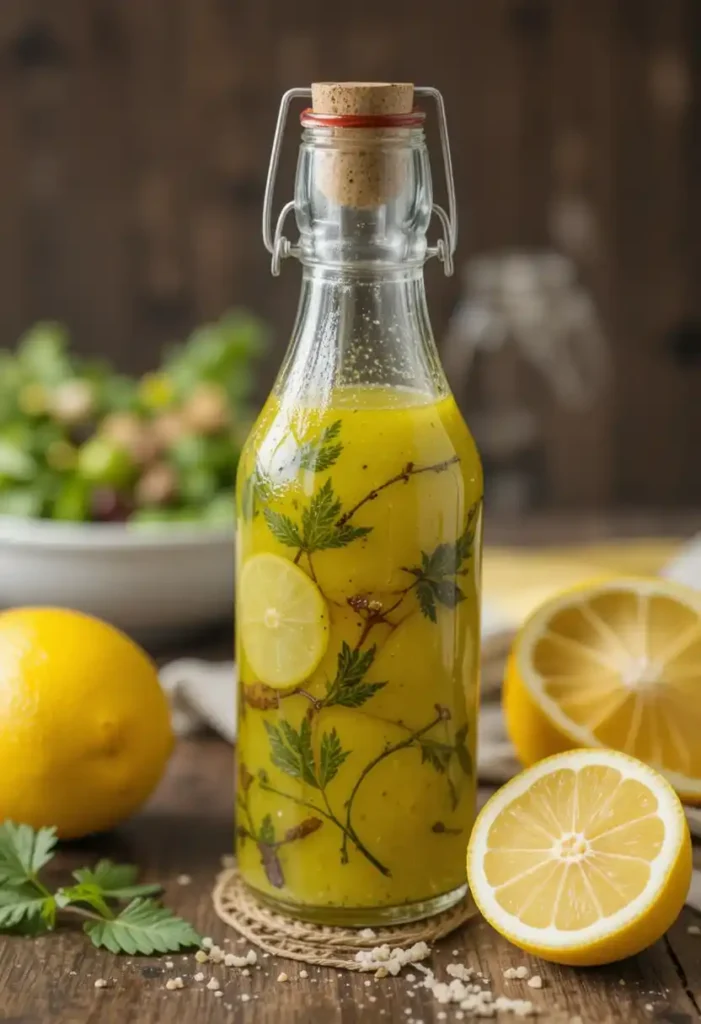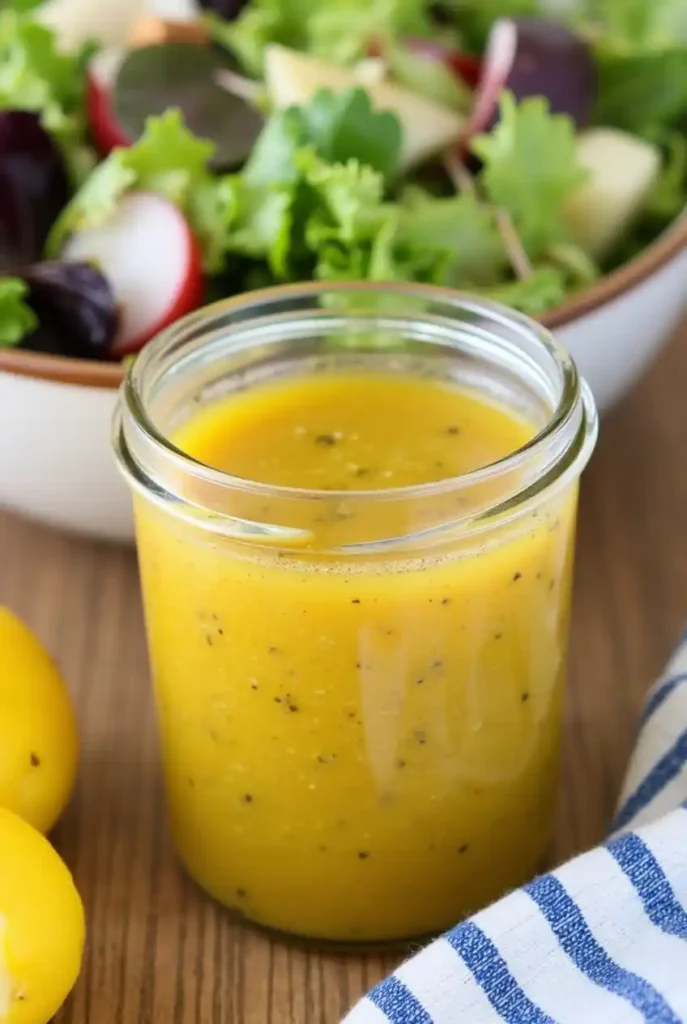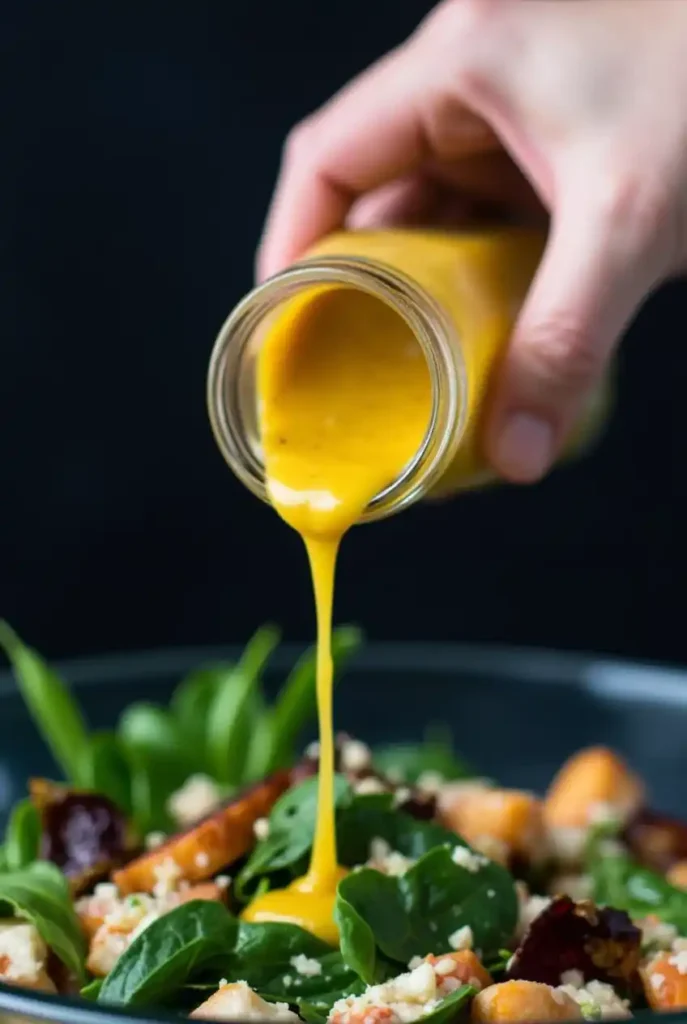Store-bought salad dressings come loaded with preservatives and refined sugars. This reality makes homemade lemon vinaigrette a game-changer for your kitchen arsenal.
Your perfect dressing needs just four simple ingredients: fresh lemon juice, olive oil, kosher salt, and black pepper. This homemade version tastes fresher and more flavorful, and you can use it on salads, as a marinade for vegetables, or to raise the flavor of your proteins.
The recipe brings more good news. You can prepare this lemon vinaigrette in minutes, and it stays fresh in your fridge for up to a week. The perfect balance of 3 parts oil to 1 part acid will make you forget store-bought dressings forever.
Ready to create the perfect lemon vinaigrette? Let’s tuck into our foolproof recipe!
Table of Contents
The Science Behind Perfect Lemon Vinaigrette

Making the perfect lemon vinaigrette requires more than just throwing ingredients together—it’s a bit of kitchen chemistry. The science behind this dressing helps you create a smooth, flavorful mixture that coats your salad greens beautifully.
Understanding Emulsification
The magic happens at the time you combine two substances that naturally resist mixing—oil and water (or in this case, lemon juice) into a smooth mixture. Your salad leaves will end up coated in oil with a puddle of lemon juice at the bottom of your bowl without proper mixing.
That’s where emulsifiers step in. Dijon mustard becomes your secret weapon in lemon vinaigrette. It acts as a surfactant—picture a molecule that’s friendly with both water and oil. A well-emulsified dressing creates a creamy vinaigrette that not only tastes better but keeps your dressed salad fresh longer without wilting.
The Ideal Oil-to-Acid Ratio
Traditional French vinaigrette recipes call for 3 parts oil to 1 part acid. Modern chefs have started to challenge this classic approach. Many kitchen experts, including those at Bon Appétit, believe a bolder ratio brings more excitement to the plate.
A 2:1 ratio (two parts oil to one part lemon juice) creates a dressing that packs more punch without being too sharp. The perfect balance ended up depending on what you like and what’s in your salad—stronger greens can take more acid, while tender leaves need a gentler touch.
Why Fresh Ingredients Matter
Quality ingredients make your homemade lemon vinaigrette shine. To name just one example, fresh-squeezed lemon juice creates natural flavor and brightness that bottled versions just can’t match. Most bottled juices contain preservatives and miss that vibrant citrus kick.
Your choice of olive oil—single origin, cold-pressed extra virgin olive oil in a dark bottle—will substantially affect your dressing’s taste. The best olive oils leave a grassy, peppery sensation on your tongue, adding layers of flavor to your vinaigrette.
Essential Ingredients for Homemade Lemon Vinaigrette
The secret to an amazing lemon vinaigrette starts with quality ingredients. Each component plays a vital role in creating the final flavor because of the simple nature of this dressing.
Choosing the Right Lemons
Fresh lemons are better than pre-bottled juice. They give your dressing a bright, vibrant taste that bottles just can’t match. Look for lemons that feel heavy and have bright, fragrant zest at the store. Meyer lemons make a more delicate dressing because they’re sweeter and less acidic than regular lemons.
Your lemon will yield more juice if you microwave it for 20-30 seconds before squeezing. The juice and zest both add to your vinaigrette’s flavor profile. The zest contains fragrant phenolic compounds that improve the dressing’s aroma by a lot.

Selecting Quality Olive Oil
High-quality olive oil is the foundation of great vinaigrette. Extra virgin olive oil, especially first cold-pressed varieties, gives the best flavor base. You’ll find olive oils in three intensity profiles: delicate, medium, and robust. Medium olive oil works best for everyday vinaigrettes, while robust oils taste great with stronger flavors like arugula or blue cheese.
Watch out for blended oils. Check the labels to make sure you’re getting pure olive oil without added canola or refined oils.
Optional Add-ins for Flavor Enhancement
A simple lemon vinaigrette needs just lemon juice, olive oil, salt, and pepper. These extra ingredients can reshape the scene from simple to spectacular:
- Dijon mustard: It adds tangy depth and helps your dressing stay blended longer as an emulsifier
- Sweeteners: Honey or maple syrup balance the acidity and any bitter notes
- Aromatics: Minced garlic, shallots, or fresh herbs like thyme or basil create complexity
- Texture enhancers: Fine-chopped nuts or a sprinkle of Parmesan cheese add interesting layers
Try these add-ins to create your own signature lemon vinaigrette that’s better than anything from the store.
Step-by-Step Vinaigrette Recipe
Let’s make a foolproof lemon vinaigrette with our quality ingredients. This simple process will give a perfect emulsion that won’t separate into an oily mess!
Preparing Your Ingredients
Here’s everything you need to create your homemade lemon vinaigrette:
- 2-3 tablespoons fresh lemon juice (from about 1 medium lemon)
- 1 teaspoon lemon zest (optional but recommended)
- 1-2 teaspoons Dijon mustard
- 1 small clove garlic or 2 tablespoons finely chopped shallot
- ¼ teaspoon kosher salt
- Freshly ground black pepper
- ¼ cup olive oil
The aromatics need some prep work. Mince the garlic or shallot into tiny pieces to avoid overwhelming individual bites. When zesting the lemon, just grate the yellow outer layer and skip the bitter white pith underneath.

Mixing Method: Whisking vs. Shaking
You can mix your lemon vinaigrette three different ways:
Whisking Method: Combine lemon juice, mustard, garlic/shallot, salt and pepper in a small bowl. Stream the olive oil slowly while whisking until the mixture turns creamy and emulsified. This works best when you need the dressing right away.
Shaking Method: Add all ingredients except oil in a jar with a tight-fitting lid. Shake to dissolve the salt, add oil and shake hard for about 30 seconds until combined. This method makes the dressing perfect to make ahead or take anywhere.
Blending Method: The blender or food processor creates ultra-creamy results. Add all ingredients and slowly pour oil while the machine runs. Your emulsion will stay stable longer this way.
Visual Cues for Perfect Consistency
A properly emulsified lemon vinaigrette shows clear signs of success:
The dressing should look creamy instead of clear, without oil and lemon juice floating separately. You want it slightly thick but pourable—not watery like the separate ingredients or thick like mayonnaise.
Don’t worry if your dressing separates after sitting around. Even the best homemade vinaigrettes do this. Just give it a quick shake or whisk before using, and your dressing will come right back together.
Troubleshooting Your Lemon Vinaigrette
Home chefs can run into problems with their lemon vinaigrette, no matter how skilled they are. The good news is you can fix most dressing mishaps with a few simple techniques.
Fixing a Broken Emulsion
You’ll know your lemon vinaigrette has broken when the oil splits from the lemon juice. This creates a thin, watery dressing with oil floating on top. Here are some reliable ways to rescue it:
Start by putting a teaspoon of lemon juice or water in a clean bowl. Add a small amount of the broken dressing and whisk it vigorously to create a new, stable emulsion. Once that forms, slowly pour in the remaining broken vinaigrette as you keep whisking.
Another option is to make a fresh emulsion with an egg yolk and lemon juice, then gradually mix in your broken dressing. This works especially when you have egg yolks that contain lecithin, a powerful emulsifier.
A quick fix is to put your separated dressing in a jar and give it a good shake. This can bring the emulsion back together for a short time.
Adjusting Flavor Balance
Sometimes your lemon vinaigrette might hold together perfectly but taste off-balance. Here’s how to fix common flavor problems:
Too acidic? Add something creamy to smooth it out, like a touch of honey or maple syrup. Extra olive oil can help soften too much acidity.
Too oily? Add more acid—a splash of lemon juice or vinegar will brighten things up.
Too salty? Add honey or maple syrup to balance it out.
Too bland? Fresh herbs, grated Parmesan, or a pinch more salt will boost the flavor.

Common Mistakes to Avoid
You can avoid future vinaigrette issues by watching out for these pitfalls:
- Adding oil too quickly: Pour oil in slowly while whisking to get proper emulsification.
- Using cold ingredients: Let refrigerated items reach room temperature before mixing them together.
- Skipping the emulsifier: Dijon mustard isn’t just about flavor—it’s a vital ingredient that helps oil and lemon juice combine.
- Improper ratio: A 3:1 oil-to-acid ratio is the foundation of a balanced dressing.
- Neglecting proper storage: Well-emulsified dressings will still separate in the fridge—let them warm up and shake before using.
Note that fixing vinaigrettes is more art than science. Trust what your taste buds tell you and adjust as needed!
Storing and Using Your Homemade Dressing
You’ve mastered your lemon vinaigrette recipe, and now it’s time to store it right to keep that fresh flavor. Homemade dressings need extra care since they don’t have the preservatives you’ll find in store-bought versions.
Proper Storage Containers
Glass containers are your best bet for storing lemon vinaigrette. They won’t react with the ingredients or leave any unwanted flavors in your dressing. The key is finding containers with lids that seal tight so you can shake without spills.
Here are some great options:
Mason jars with screw-top lids work perfectly and make shaking easy. Wide-mouth jars help you add ingredients without making a mess. Cruet-style bottles with pour spouts let you drizzle your dressing just right over salads and cooked dishes.
Small stainless steel containers with silicone-sealed lids are a great way to get your vinaigrette from home to work without any leaks.
Shelf Life and Refrigeration Tips
Your homemade vinaigrette needs to go in the fridge if it has fresh ingredients like garlic, herbs, and citrus juice. It should stay good for 3-5 days. Simple versions with just oil, vinegar, salt, and pepper can last up to a week when stored properly.
The olive oil will get solid in the fridge. Let your dressing sit out for 10-15 minutes before using it, then give it a good shake to mix everything back together.
Food safety is important – vinaigrettes with fresh herbs, vegetables, or citrus need refrigeration to stop bacteria from growing, especially those pesky Clostridium botulinum spores.
Creative Ways to Use Beyond Salads
This zingy dressing can do so much more than dress a salad:
- Drizzle it over roasted Brussels sprouts, asparagus, or cauliflower
- Use it as a bright marinade for chicken, fish, or tofu
- Toss it with farro, quinoa, or couscous to make tasty side dishes
- Brush it on grilled vegetables just before they’re done
- Add it to pasta salads or grain bowls for extra zip
- Soak sliced red onions or other vegetables in it for quick pickled sides
Store your homemade lemon vinaigrette right, and you’ll have a versatile kitchen helper that raises the flavor of countless dishes.

Conclusion
A homemade lemon vinaigrette can turn ordinary salads into unforgettable meals. Fresh ingredients, proper emulsification techniques, and the right oil-to-acid ratio create a dressing that outperforms any store-bought option.
This foolproof recipe and troubleshooting guide will help you craft perfect vinaigrettes with confidence. Quality ingredients make all the difference – your vinaigrette’s taste depends on fresh lemons and premium olive oil.
The versatility of this dressing extends way beyond the reach and influence of salads. You can enhance roasted vegetables and create flavorful marinades. The simple recipe serves as an excellent foundation, and you can experiment with different ingredients to create your signature version. To discover more recipes that will raise your cooking skills, visit our blog “recipesnutritious.com”.
Your homemade vinaigrette needs proper storage. You can adjust flavors as needed and enjoy a preservative-free dressing that brings restaurant-quality taste right to your table.
FAQs
Q1. What’s the ideal ratio for making lemon vinaigrette? While traditional recipes suggest a 3:1 oil-to-acid ratio, modern preferences lean towards a 2:1 ratio for a more flavorful dressing. Adjust according to your taste and the type of salad you’re preparing.
Q2. How can I prevent my lemon vinaigrette from separating? Use an emulsifier like Dijon mustard and whisk vigorously while slowly adding the oil. Alternatively, shake all ingredients in a jar with a tight-fitting lid. If separation occurs, simply re-shake or whisk before use.
Q3. What are the essential ingredients for a basic lemon vinaigrette? A basic lemon vinaigrette requires fresh lemon juice, high-quality olive oil, kosher salt, and black pepper. Optional add-ins like Dijon mustard, honey, or herbs can enhance flavor and texture.
Q4. How long does homemade lemon vinaigrette last? When properly stored in the refrigerator, homemade lemon vinaigrette containing fresh ingredients typically lasts 3-5 days. Simple vinaigrettes without fresh components can last up to a week.
Q5. Can lemon vinaigrette be used for more than just salads? Absolutely! Lemon vinaigrette is versatile and can be used as a marinade for proteins, drizzled over roasted vegetables, tossed with grains, or used to add brightness to pasta salads and grain bowls.

